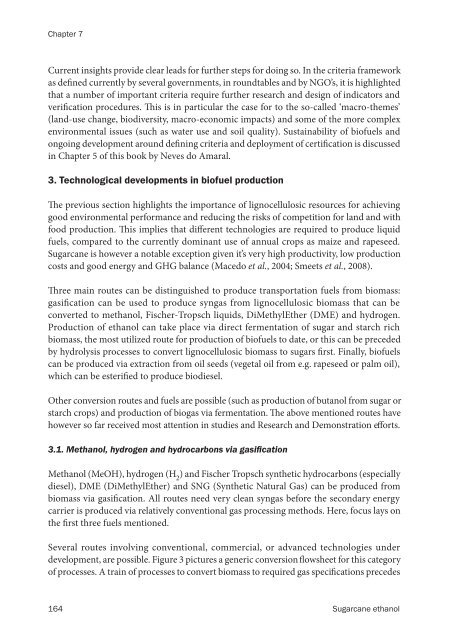Sugarcane ethanol: Contributions to climate change - BAFF
Sugarcane ethanol: Contributions to climate change - BAFF
Sugarcane ethanol: Contributions to climate change - BAFF
Create successful ePaper yourself
Turn your PDF publications into a flip-book with our unique Google optimized e-Paper software.
Chapter 7<br />
Current insights provide clear leads for further steps for doing so. In the criteria framework<br />
as de�ned currently by several governments, in roundtables and by NGO’s, it is highlighted<br />
that a number of important criteria require further research and design of indica<strong>to</strong>rs and<br />
veri�cation procedures. �is is in particular the case for <strong>to</strong> the so-called ‘macro-themes’<br />
(land-use <strong>change</strong>, biodiversity, macro-economic impacts) and some of the more complex<br />
environmental issues (such as water use and soil quality). Sustainability of biofuels and<br />
ongoing development around de�ning criteria and deployment of certi�cation is discussed<br />
in Chapter 5 of this book by Neves do Amaral.<br />
3. Technological developments in biofuel production<br />
�e previous section highlights the importance of lignocellulosic resources for achieving<br />
good environmental performance and reducing the risks of competition for land and with<br />
food production. �is implies that di�erent technologies are required <strong>to</strong> produce liquid<br />
fuels, compared <strong>to</strong> the currently dominant use of annual crops as maize and rapeseed.<br />
<strong>Sugarcane</strong> is however a notable exception given it’s very high productivity, low production<br />
costs and good energy and GHG balance (Macedo et al., 2004; Smeets et al., 2008).<br />
�ree main routes can be distinguished <strong>to</strong> produce transportation fuels from biomass:<br />
gasi�cation can be used <strong>to</strong> produce syngas from lignocellulosic biomass that can be<br />
converted <strong>to</strong> m<strong>ethanol</strong>, Fischer-Tropsch liquids, DiMethylEther (DME) and hydrogen.<br />
Production of <strong>ethanol</strong> can take place via direct fermentation of sugar and starch rich<br />
biomass, the most utilized route for production of biofuels <strong>to</strong> date, or this can be preceded<br />
by hydrolysis processes <strong>to</strong> convert lignocellulosic biomass <strong>to</strong> sugars �rst. Finally, biofuels<br />
can be produced via extraction from oil seeds (vegetal oil from e.g. rapeseed or palm oil),<br />
which can be esteri�ed <strong>to</strong> produce biodiesel.<br />
Other conversion routes and fuels are possible (such as production of butanol from sugar or<br />
starch crops) and production of biogas via fermentation. �e above mentioned routes have<br />
however so far received most attention in studies and Research and Demonstration e�orts.<br />
3.1. M<strong>ethanol</strong>, hydrogen and hydrocarbons via gasification<br />
M<strong>ethanol</strong> (MeOH), hydrogen (H 2 ) and Fischer Tropsch synthetic hydrocarbons (especially<br />
diesel), DME (DiMethylEther) and SNG (Synthetic Natural Gas) can be produced from<br />
biomass via gasi�cation. All routes need very clean syngas before the secondary energy<br />
carrier is produced via relatively conventional gas processing methods. Here, focus lays on<br />
the �rst three fuels mentioned.<br />
Several routes involving conventional, commercial, or advanced technologies under<br />
development, are possible. Figure 3 pictures a generic conversion �owsheet for this category<br />
of processes. A train of processes <strong>to</strong> convert biomass <strong>to</strong> required gas speci�cations precedes<br />
164 <strong>Sugarcane</strong> <strong>ethanol</strong>












